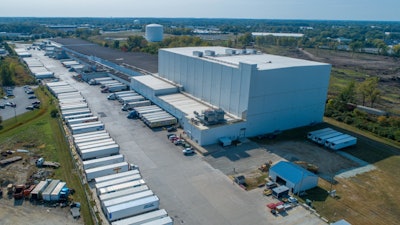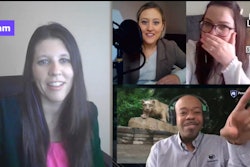
Embracing prosperity while protecting the planet – it’s an age-old challenge that begs the question, “What are you doing to make your purpose pay?” As things like climate change and social injustice create a line of sight, companies must look beyond bottom lines and profit margins to drive impact through corporate social responsibility.
The thing about sustainability is that it applies to all types of businesses, affects every discipline within a business, and generates outcomes that are felt by employees, customers, partners and investors. It’s far reaching and very impactful; simply put, a sustainability strategy can make or break a company.
Creating well-rounded goals
Whether you’re new to sustainability or looking to refresh your strategy, familiarize yourself with the 17 Sustainable Development Goals created by the United Nations General Assembly. These goals speak to environmental, social and governance (ESG) actions, and there’s no doubt at least one of them aligns with your business’s overall strategy.
Cold chain industry operations line up with several of these goals. The United Nations estimates that one third of the world’s food supply is wasted due to the inability to preserve food for consumption. Companies that own and operate temperature-controlled warehouses offer supply chain solutions that preserve product quality and minimize food waste, improving access to food. According to the United Nations, increased access “improves our economies, health, education, equality and social development.”
Embracing sustainability means that global cold chain organizations must continually evaluate innovation and technology to drive improvements in energy efficiencies, water usage, greenhouse gas (GHG) emission reductions and overall stewardship of our resources.
Small changes have big impact
Creating a sustainability strategy can be overwhelming, so there’s no shame in starting small. Assemble leadership and employees to spark conversation and action. Americold’s site-level energy teams meet monthly to discuss site-level performance and opportunities. District-level energy champions raise awareness, drive performance and rally support.
As for projects, energy-efficient lighting is an example of an investment that companies should make – and many already have – to drive down usage. Americold conducts lighting audits to prioritize facilities for LED retrofitting projects. In 2020, we demonstrated the practice of making purpose pay by converting nine cold storage sites to LEDs. The sustainability initiative resulted in a total reduction of 4.5 million kilowatt hours (kWh), 3,200 metric tons of carbon dioxide equivalent - greenhouse gas (CO2E GHG) and more than $640,000 in annual savings. Variable frequency drivers (VFDs) were also installed at four cold storage sites. Controlling the speed and torque of refrigeration system motors, this technology resulted in an annual reduction of 1.5M Kwh, avoidance of 1,062 metric tons CO2E GHG, and more than $165,000 in annual savings.
To help drive decision making, companies can use software that increases visibility to energy usage in real-time. Reviewing 2-month-old energy bills to determine why usage fluctuations is ineffective. Embracing a digital approach, Americold’s facilities are equipped to capture meter-level usage data. With this data, Americold can compare usage day-to-day, year-over-year or facility-to-facility. A comparative analysis cadence provides the formalized process to quantitatively and qualitatively evaluate data and determine which levers to pull to deliver continuous improvement.
Big projects also have big impact
Climate change is a very real danger that comes with far-reaching financial, strategic and business implications. According to the Intergovernmental Panel on Climate Change (IPCC), a 2°C warming could bring extreme heatwaves, thereby driving up energy costs and increasing food shortages in places like Southern Africa and the Mediterranean. In the United States, climate change threatens fresh water resources and gross domestic product (GDP) growth.
One strategy to consider is leveraging renewable energy. While not an easy nor inexpensive undertaking, renewable energy projects provide long-term, impactful benefits to both companies and the environment. Americold kicked off its long-term solar strategy in 2013 and at the end of 2020, managed five solar projects that supply power to five Americold facilities. In 2021, Americold’s solar energy system will grow and is expected to generate 11.9 million kWh of extra power to be sold back to local utility companies. These projects will also help Americold avoid releasing an estimated 8,414 metric tons of harmful CO2E GHG into the environment.
Moving forward, Americold has targeted additional solar power projects in its 5- and 10-year strategic sustainability capital plans.
Another complex, and perhaps unique, strategy includes rainwater harvesting to decrease fresh water and energy usage. Temperature-controlled warehouses utilize refrigeration condensers to maintain their environments. Many of the condensers require potable water to transfer heat via evaporation from the condenser.
A rainwater harvesting system captures rainfall on a rooftop, sends it to storage ponds or tanks, then treats it using a proprietary method. This recycled water replaces municipal water as feed for the facility’s refrigerated condensers. The system reduces wastewater treatment costs as well as storm water run-off, thereby diminishing contamination from surface water.
Six Americold facilities are equipped with rainwater harvesting systems. The newest system in Indianapolis, Ind., has reduced municipal water consumption by 70%. That’s a reduction of 6 million gallons per year—enough water to fill more than nine Olympic-size swimming pools. Wastewater treatment costs and water conditioning costs also decreased, including a 71,000 pound per year reduction in water softener salt savings.
Thinking outside the company
“Partnerships for the Goals” is one of the UN Sustainable Development Goals that every company can embrace. The goal speaks to the importance of strong relationships in achieving sustainable development. These relationships can be forged on the global, regional, national or local level and should focus on uniting to build a better planet.
Americold puts this practice into motion with the Waste Walk program in partnership with Feed the Children. Americold’s Energy Team has dedicated time to educate and train Feed the Children affiliate organizations on low-cost, energy-saving solutions. Americold walks the spaces, inspects the facilities and equipment and reviews usage reports. They discuss simple action items to reduce overall energy consumption and identify low-cost opportunities for improvement. The most recent walk uncovered nearly $10,000 worth of potential energy-related operational savings.
There is, of course, no single sustainability strategy that will play across every industry and every business. The best approach is to follow your purpose and make it pay.


















